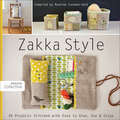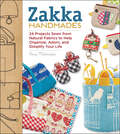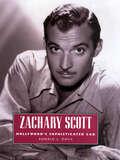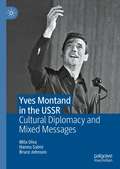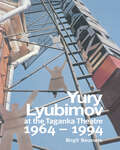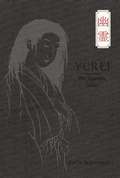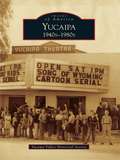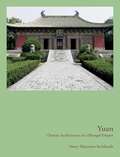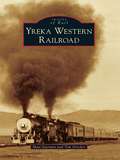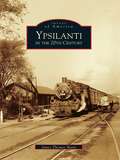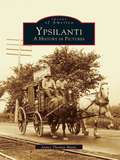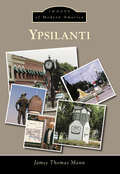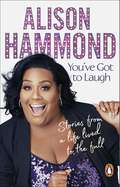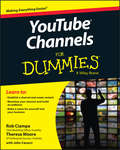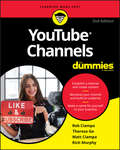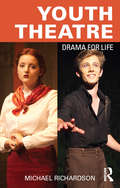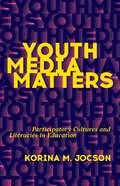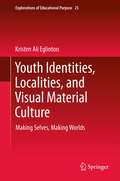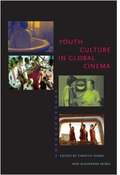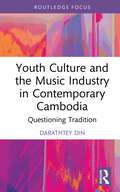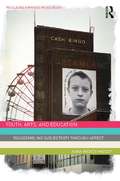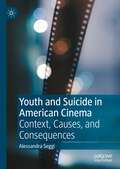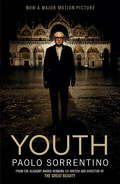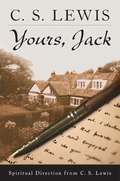- Table View
- List View
Zakka Style: 24 Projects Stitched with Ease to Give, Use & Enjoy (Design Collective)
by Rashida Coleman-HaleCreate charming fabric crafts inspired by the Japanese design movement that you can use to brighten up your home or give as gifts to friends.Discover the hottest new trend in fabric crafting—Zakka! These clever, modern projects are a cinch to sew using basic patchwork, appliqué, and embroidery. It’s scrap-friendly and fun for all sewing skill levels.Rashida Coleman-Hale has gathered talented designers from around the world to bring you 24 delightful Zakka projects. Zakka, a Japanese term meaning “many things,” is all about all the little things that improve your home and appearance. Create a one-of-a-kind picture frame, a stylish bread bag, a whimsical bookmark, a chic tote, and so much more. You’ll love these bright, imaginative designs-make them for yourself and everyone you know!Featuring contributions by Amanda Jennings, Amy Sinibaldi, Ayumi Takahashi, Christie Fowler, Holly Keller, Julia Bravo, Karyn Valino, Kat Mew, Katrien Van Deuren, Kim Kruzich, Larissa Holland, Laurraine Yuyama, Leslie Good, Lisa Billings, Masko Jefferson, Meg Spaeth, Melody Miller, Mette Robl, Nova Flitter, Pascal Mestdagh, Rachel Roxburgh, Shannon Dreval, Sonia Cantie, and Theresia Cookson.Award-Winner in the Crafts/Hobbies/How-To category of the 2012 International Book AwardsPraise for Zakka Style“The term “zakka” . . . has become synonymous with a kind of simple charm and uniqueness—something handmade that is useful and pleasing. . . . This book is another wonderful source for gift ideas and sweet little knick-knacks to make ‘just because.’” —Australian Homespun Magazine
Zakka Handmades: 24 Projects Sewn from Natural Fabrics to Help Organize, Adorn, and Simplify Your Life
by Amy MorinakaLearn how to sew simple, clever things that organize your home and help with daily tasks with Zakka Handmades! These incredibly useful projects include pouches and bags, small toys and baby items, and handy kitchen accessories. Some of the author&’s sewn items also incorporate simple crochet. In Japanese, zakka means &“household goods,&” referring to items for domestic use—tableware, kitchenware, containers of various kinds, even simple clothing. What all the items have in common is a simple, fresh, handmade aesthetic; a subtle, clever wit; and absolute usefulness and practicality.
Zachary Scott: Hollywood's Sophisticated Cad (Hollywood Legends Series)
by Ronald L. DavisThroughout the 1940s, Zachary Scott (1914-1965) was the model for sophisticated, debonair villains in American film. His best-known roles include a mysterious criminal in The Mask of Dimitrios and the indolent husband in Mildred Pierce. He garnered further acclaim for his portrayal of villains in Her Kind of Man, Danger Signal, and South of St. Louis. Although he earned critical praise for his performance as a heroic tenant farmer in Jean Renoir's The Southerner, Scott never quite escaped typecasting. In Zachary Scott: Hollywood's Sophisticated Cad, Ronald L. Davis writes an appealing biography of the film star. Scott grew up in privileged circumstances—his father was a distinguished physician; his grandfather was a pioneer cattle baron—and was expected to follow his father into medical practice. Instead, Scott began to pursue a career in theater while studying at the University of Texas and subsequently worked his way on a ship to England to pursue acting. Upon his return to America, he began to look for work in New York. Excelling on stage and screen throughout the 1940s, Scott seemed destined for stardom. By the end of 1950, however, he had suffered through a turbulent divorce. A rafting accident left him badly shaken and clinically depressed. His frustration over his roles mounted, and he began to drink heavily. He remarried and spent the rest of his career concentrating on stage and television work. Although Scott continued to perform occasionally in films, he never reclaimed the level of stardom that he had in the mid-1940s. To reconstruct Scott's life, Davis uses interviews with Scott and colleagues and reviews, articles, and archival correspondence from the Scott papers at the University of Texas and from the Warner Brothers Archives. The result is a portrait of a talented actor who was rarely allowed to show his versatility on the screen.
Yves Montand in the USSR: Cultural Diplomacy and Mixed Messages
by Mila Oiva Hannu Salmi Bruce JohnsonThis volume is the first book-length account of Yves Montand’s controversial tour of the Soviet Union at the turn of the years 1956/57. It traces the mixed messages of this internationally visible act of cultural diplomacy in the middle of the turbulent Cold War. It also provides an account of the celebrated French singer-actor’s controversial career, his dedication to music and to peace activism, as well as his widespread fandom in the USSR. The book describes the political background for the events of the year 1956, including the changing Soviet atmosphere after Stalin’s death, portrays the rising transnational stardom of Montand in the 1940s and 1950s, and explores the controversies aroused by his plan to visit Moscow after the Hungarian Uprising. The book pays particular attention to Montand’s reception in the USSR and his concert performances, drawing on unique archival material and oral history interviews, and analyses the documentary Yves Montand Sings (1957) released immediately after his visit.
Yuri Lyubimov: At The Taganka Theatre, 1964-1994
by B. BeumersA study of Yury Lyubimov's tempestuous career and his style of theatre during his thirty years at the Taganka Theatre. This work traces the development of his ideas, from his arrival at the theatre in 1964 through to his explusion in 1984, and his period of exile in the West until his return in 1989 to a much-changed Russia. Tracing Lyubimov's work play by play, the book uncovers an individual doomed to be at odds with the prevailing political and social climate of his literary contemporaries.
Yurei
by Zack Davisson"I lived in a haunted apartment." Zack Davisson opens this definitive work on Japan's ghosts, or yurei, with a personal tale about the spirit world. Eerie red marks on the apartment's ceiling kept Zack and his wife on edge. The landlord warned them not to open a door in the apartment that led to nowhere. "Our Japanese visitors had no problem putting a name to it . . . they would sense the vibes of the place, look around a bit and inevitably say 'Ahhh . . . yurei ga deteru.' There is a yurei here."Combining his lifelong interest in Japanese tradition and his personal experiences with these vengeful spirits, Davisson launches an investigation into the origin, popularization, and continued existence of yurei in Japan. Juxtaposing historical documents and legends against contemporary yurei-based horror films such as The Ring, Davisson explores the persistence of this paranormal phenomenon in modern day Japan and its continued spread throughout the West.Zack Davisson is a translator, writer, and scholar of Japanese folklore and ghosts. He is the translator of Mizuki Shigeru's Showa 1926-1939: A History of Japan and a translator and contributor to Kitaro. He also worked as a researcher and on-screen talent for National Geographic's TV special Japan: Lost Souls of Okinawa. He writes extensively about Japanese ghost stories at his website, hyakumonogatari.com.
Yucaipa: 1940s-1980s
by Yucaipa Valley Historical SocietyWhen the soldiers returned after the end of World War II, the community of Yucaipa celebrated the victory and settled into a new era that would someday become known as the "good old days." Located in the foothills of the San Bernardino Mountains at the edge of the desert, the area and the climate was perfect for not only maintaining the agriculture-based economy, but establishing more businesses, churches, schools, and whole new neighborhoods. The first tracts of homes were followed with mobile home parks for new retirees looking for a real hometown, which they found in Yucaipa. People raised their children in a village-style environment, and the whole family could enjoy life with enthusiasm. There was plenty to do, and traditions that are continuing today were established in the form of parades, fairs, sports programs, and the enrichment opportunities of good schools, a college, and the community's love of its land and each other.
Yuan: Chinese Architecture in a Mongol Empire
by Nancy SteinhardtA monumental illustrated survey of the architecture of thirteenth- and fourteenth-century ChinaThe Yuan dynasty endured for a century, leaving behind an architectural legacy without equal, from palaces, temples, and pagodas to pavilions, tombs, and stages. With a history enlivened by the likes of Khubilai Khan and Marco Polo, this spectacular empire spanned the breadth of China and far, far beyond, but its rulers were Mongols. Yuan presents the first comprehensive study in English of the architecture of China under Mongol rule.In this richly illustrated book, Nancy Shatzman Steinhardt looks at cities such as the legendary Shangdu—inspiration for Samuel Taylor Coleridge’s Xanadu—as well as the architecture the Mongols encountered on their routes of conquest. She examines the buildings and monuments of diverse faiths in China during the period, from Buddhist and Daoist to Confucian, Islamic, and Christian, as well as unusual structures such as observatories, archways, stone and metal buildings, and sarcophaguses. Steinhardt dispels long-standing views of the Mongols as destroyers of cities and architecture across Asia, showing how the khans and their families built more than they tore down. She demonstrates that the stipulations of the Chinese building system were powerful and resilient enough to guide the architecture that rose under Mongolian rule.Drawing on Steinhardt’s groundbreaking textual research in numerous languages as well as her pioneering fieldwork at sites across East Asia, Yuan will become the standard reference on this critical period of cultural and artistic exchange.
Yreka Western Railroad
by Matt Starman Tim StrickerThe city of Yreka was determined to have a railroad. When the Southern Pacific Railroad decided in 1883 to bypass Yreka, the citizens constructed their own railroad known as the Yreka Railroad Company. This railroad managed to eke out a living over the next few decades. In the 1930s, the railroad was reincorporated as the Yreka Western Railroad. By the mid-1930s, the railroad went bankrupt and was forced into receivership, and a new manager was put in charge. Through perseverance of the new manager, the railroad began to grow and prosper. By the late 1970s, the railroad once again started to decline, but as in the past, it managed to hold on. In 1986, the railroad started an excursion train known as the "Blue Goose," and steam locomotive No. 19 was added in 1989. Throughout all the hardships, the railroad still continues today and has been given the nickname "the Little Railroad that Refuses to Die."
Ypsilanti in the 20th Century
by James Thomas MannFrom 1900 through 1975, the city of Ypsilanti underwent a multitude of changes as it developed from a small farming community into a center of education and business. The rise of the automobile and the insurgence of auto manufacturing, the progress of local arts and theater, the opening of the Bomber Plant at Willow Run, and the transformation of a teachers' college into Eastern Michigan University are just a few of these historic developments. This book, a companion to Ypsilanti: A History in Pictures, chronicles Ypsilanti's magnificent growth throughout the twentieth century, and the celebrated people, places, and events that helped shape the city as it is known today.
Ypsilanti: A History in Pictures
by James Thomas MannIn the latter half of the 19th century, the city of Ypsilanti went through a rapid transition from a small farming community to a center of education and business. By 1900, Ypsilanti was nationally known for three things: the Michigan Central Gardens, the mineral wells, and underwear. The gardens were designed by famed landscape gardener John Laidlaw, who studied gardening in his native Scotland before coming to the United States. Beginning in the 1880s, people came from miles away to bathe in Ypsilanti's mineral waters, which were said to cure just about anything. And for many years, Ypsilanti was the home of the Underwear Factory, where the finest full body union suits were made.Dr. Helen McAndrew was the first woman doctor in Ypsilanti, opening her practice in 1854. She and her husband were active in the Underground Railroad, which Ypsilanti played a very active role in. Ypsilanti is also the home of Eastern Michigan University, founded in 1848, becoming the first normal school west of the Alleghenies.
Ypsilanti: A History In Pictures (Images of Modern America)
by James Thomas MannYpsilanti, Michigan, home to Eastern Michigan University, is a small city where a great deal happens. This is a community with a strong sense of history and historic preservation. Homes and buildings about to fall in on themselves in the 1960s were preserved and restored and have found new uses today. It is a place of festivals, parades, concerts, and performances. There have been problems and turmoil, such as the time when the president of Eastern Michigan University needed a new house, but in each instance the people of Ypsilanti have come through stronger than before. Here, local historian James Mann shares why the people of Ypsilanti take pride in their city.
You’ve Got To Laugh: Stories from a Life Lived to the Full
by Alison HammondThe hilarious, heartwarming and joyful memoir from much-loved presenter Alison Hammond, host of ITV's This Morning.'This woman's laugh is like gold dust' Huffington Post '[A] national treasure' Metro 'I always say a day is wasted without laughter . . .' Alison Hammond loves to laugh. And the nation laughs with her. Her sunny personality and zest for life have brought joy to millions and made her one of the UK's best-loved television presenters. Known for her hilarious and unforgettable interviews with Hollywood A-listers, Alison is also responsible for countless classic moments of broadcasting gold - from getting stuck on a caravan door to delivering Christmas cash dressed as an elf. But who is Alison Hammond really, and how did she become the personality we know and love? Shaped by the influence of her incredible mum, Alison went from small roles on television shows as a youngster to that life-changing appearance on Big Brother, before landing her dream job on This Morning. And through it all, she found the joy in every day, the positives in any situation. You've Got to Laugh gives a never-before-seen insight into Alison's life: her loves, her losses - with a side order of gossip. As well as being a hugely entertaining and uplifting read, Alison's story will inspire you to grab life with both hands and make the most of every single moment. 'Interviewer extraordinaire, reigning queen of the huns, and an out-and-out national treasure' Bustle
YouTube Channels For Dummies
by John Carucci Theresa Moore Adam Wescott Stan Muller Rob CiampaCreate content and build a YouTube channel like a pro Written by a successful YouTube channel producer, YouTube Channels For Dummies shows you how to create content, establish a channel, build an audience, and successfully monetize video content online. Beginning with the basics, it shows you how to establish a channel, join a partner program, and develop a content plan. Next, you'll gain insight into how to create content that builds a channel, enhance the viral nature of a video, encourage subscriptions, and earn repeat views. If that weren't enough, you'll go on even further to learn how to get the word out about your channel and discover ways to enhance your potential profits. That's a lot of info--but it's easily digestible and simple to put into practice when it's provided in the accessible and trusted For Dummies format. YouTube is the third most-visited website on the Internet, making it prime real estate for anyone seeking customers, celebrity, or education. If you want to harness this irresistible platform and reach a global platform, YouTube Channels For Dummies makes it easy. In no time, you'll have the know-how to create a YouTube channel with regular subscribers who watch, re-watch, and share your videos. Includes ten easy tips for growing a raptured YouTube audience Details how to enhance the viral nature of a video Shows you how to create and maintain a YouTube channel that generates views and revenue Written by the producer of a leading YouTube channel
YouTube Channels For Dummies
by Rob Ciampa Theresa Go Matt Ciampa Rich MurphyCreate a YouTube channel that draws subscribers with top-notch content YouTube has the eyes and ears of two billion monthly users. YouTube Channels for Dummies, 2nd Edition offers proven steps to attracting a chunk of those billions to your personal or business channel. This updated guide offers insight from a quartet of YouTube channel content creators, managers, marketers, and analysts as they share the secrets of creating great content, building an audience, and interacting with your viewers. The book includes information on: · Setting up a channel · Creating videos that attract viewers · Putting together a video studio · Editing your final product · Reaching your target audience · Interacting with your fans · Building a profitable business · Tips on copyright law Written for both the budding YouTube creator and the business professional seeking to boost their company’s profile on the popular social networking site, YouTube Channels for Dummies allows its readers to access the over two billion active YouTube users who log on each day. Learn how to create a channel, build a YouTube following, and get insight on content creation, planning, and marketing from established YouTube creators.
Youth Theatre: Drama for Life
by Michael RichardsonYouth Theatre: Drama for Life defines the youth theatre process, by outlining its constituent parts and explaining how these activities work in order to support young people’s development. As well as describing what?is done in youth theatre, it also explores why it’s done and how to ensure the best possible outcomes. The book is in four parts: Part 1 explores the nature and purpose of youth theatre, drawing on Michael Richardson’s extensive personal experience as a practitioner and manager. Part 2 explains, in detail, the youth theatre process: warming up, playing games, voice work, developing skills, devising and the presentation of devised work. Part 3 discusses how to create an appropriate environment within which the youth theatre process can be most effectively applied. Part 4 covers the most common applications of the youth theatre process, namely using it in different education environments; and youth theatre productions and performance. On top of this, two appendices give a list of over 60 games that are useful to use in youth theatre; and a list of recommended further reading that supports this book. As well as giving key tips and advice from his own invaluable experience, Richardson offers comments from practitioners and participants on what makes a successful youth theatre experience. Michael Richardson has worked in youth theatre for over 20 years, has been involved in the training of other practitioners, and in the strategic development of the youth theatre sector in the UK.
Youth Planning Charrettes: A Manual for Planners, Teachers, and Youth Advocates
by Bruce RaceInvest in the future! Involve young people in planning. Learn how to design charrettes, starting with workshops and ending with lessons learned. This book explores various approaches to involving youth in schools, museums, and citizen groups. It's a complete guide to successful community charrettes for younger participants (K-8). First published in 1998. Routledge is an imprint of Taylor & Francis, an informa company.
Youth Media Matters: Participatory Cultures and Literacies in Education
by Korina M. JocsonIn an information age of youth social movements, Youth Media Matters examines how young people are using new media technologies to tell stories about themselves and their social worlds. They do so through joint efforts in a range of educational settings and media environments, including high school classrooms, youth media organizations, and social media sites. Korina M. Jocson draws on various theories to show how educators can harness the power of youth media to provide new opportunities for meaningful learning and “do-it-together production.” Describing the impact that youth media can have on the broader culture, Jocson demonstrates how it supports expansive literacy practices and promotes civic engagement, particularly among historically marginalized youth.In Youth Media Matters, Jocson offers a connective analysis of content area classrooms, career and technical education, literary and media arts organizations, community television stations, and colleges and universities. She provides examples of youth media work—including videos, television broadcasts, websites, and blogs—produced in the San Francisco Bay Area, Los Angeles, New York, and St. Louis. At a time when educators are increasingly attentive to participatory cultures yet constrained by top-down pedagogical requirements, Jocson highlights the knowledge production and transformative potential of youth media with import both in and out of the classroom.
Youth Identities, Localities, and Visual Material Culture
by Kristen Ali EglintonThis invaluable addition to Springer's Explorations of Educational Purpose series is a revelatory ethnographic account of the visual material culture of contemporary youths in North America. The author's detailed study follows apparently dissimilar groups (black and Latino/a in a New York City after-school club, and white and Indigenous in a small Canadian community) as they inflect their nascent identities with a sophisticated sense of visual material culture in today's globalized world. It provides detailed proof of how much ethnography can add to what we know about young people's development, in addition to its potential as a model to explore new and significant avenues in pedagogy. Supported by a wealth of ethnographic evidence, the analysis tracks its subjects' responses to strikingly diverse material ranging from autobiographical accounts by rap artists to the built environment. It shows how young people from the world's cultural epicenter, just like their counterparts in the sub-Arctic, construct racial, geographic and gender identities in ways that are subtly responsive to what they see around them, blending localized characteristics with more widely shared visual references that are now universally accessible through the Web. The work makes a persuasive case that youthful engagement with visual material culture is a relational and productive activity that is simultaneously local and global, at once constrained and enhanced by geography, and possesses a potent and life-affirming authenticity. Densely interwoven with young people's perspectives, the author's account sets out an innovative and interdisciplinary conceptual framework affording fresh insights into how today's youth assimilate what they perceive to be significant. Supported by a wealth of ethnographic evidence, the analysis tracks its subjects' responses to strikingly diverse material ranging from autobiographical accounts by rap artists to the built environment. It shows how young people from the world's cultural epicenter, just like their counterparts in the sub-Arctic, construct racial, geographic and gender identities in ways that are subtly responsive to what they see around them, blending localized characteristics with more widely shared visual references that are now universally accessible through the Web. The work makes a persuasive case that youthful engagement with visual material culture is a relational and productive activity that is simultaneously local and global, at once constrained and enhanced by geography, and possesses a potent and life-affirming authenticity. Densely interwoven with young people's perspectives, the author's account sets out an innovative and interdisciplinary conceptual framework affording fresh insights into how today's youth assimilate what they perceive to be significant. Supported by a wealth of ethnographic evidence, the analysis tracks its subjects' responses to strikingly diverse material ranging from autobiographical accounts by rap artists to the built environment. It shows how young people from the world's cultural epicenter, just like their counterparts in the sub-Arctic, construct racial, geographic and gender identities in ways that are subtly responsive to what they see around them, blending localized characteristics with more widely shared visual references that are now universally accessible through the Web. The work makes a persuasive case that youthful engagement with visual material culture is a relational and productive activity that is simultaneously local and global, at once constrained and enhanced by geography, and possesses a potent and life-affirming authenticity. Densely interwoven with young people's perspectives, the author's account sets out an innovative and interdisciplinary conceptual framework affording fresh insights into how today's youth assimilate what they perceive to be significant.
Youth Culture in Global Cinema
by Timothy Shary Alexandra SeibelComing of age is a pivotal experience for everyone. So it is no surprise that filmmakers around the globe explore the experiences of growing up in their work. From blockbuster U.S. movies such as the Harry Potter series to thought-provoking foreign films such as Bend It Like Beckham and Whale Rider, films about youth delve into young people's attitudes, styles, sexuality, race, families, cultures, class, psychology, and ideas. These cinematic representations of youth also reflect perceptions about youth in their respective cultures, as well as young people's worth to the larger society. Indeed, as the contributors to this volume make plain, films about young people open a very revealing window on the attitudes and values of cultures across the globe.
Youth Culture and the Music Industry in Contemporary Cambodia: Questioning Tradition (Routledge Focus on the Global Creative Economy)
by Darathtey DinThis book explores young Cambodians’ perceptions of their place in today’s society and how they interact with the country’s arts and culture scene. The popularity of Cambodian hip-hop among youth presents an opportunity for research to dive deeper into the roles of popular music in society and how these roles, in turn, shape Cambodian cultural identities. Research on the above-mentioned topic by local researchers is scarce. There is a gap in the research on the topic of identity, its connection to arts and culture, and how these two are positioned in a broader context of Cambodian identity politics and cultural economy. This book aims to provide a starting point for observation and conversation about youth cultural identities and the subtexts of certain narratives disseminated through music. The book contributes to the global research agenda by adding to the few voices in academia looking at localised models of cultural economies and trying to understand them based on local phenomena observed through local lenses. Utilising the author’s perspective and social experiences as a Cambodian researcher growing up and living in Cambodia, the book provides a unique perspective of the country’s cultural landscape. This will make the book of interest to all scholars of international cultural policy and the global creative economy, especially those with a particular interest in Cambodia.
Youth, Arts, and Education: Reassembling Subjectivity through Affect (Routledge Advances in Sociology)
by Anna Hickey-MoodyHow are the arts important in young people’s lives? Youth, Arts and Education offers a groundbreaking theory of arts education. Anna Hickey-Moody explores how the arts are ways of belonging, resisting, being governed and being heard. Through examples from the United Kingdom and Australia, Anna Hickey-Moody shows the cultural significance of the kinds of learning that occur in and through arts. Drawing on the thought of Gilles Deleuze, she develops the theory of affective pedagogy, which explains the process of learning that happens through aesthetics. Bridging divides between critical pedagogical theory, youth studies and arts education scholarship, this book: Explains the cultural significance of the kinds of learning that occur in and through arts Advances a theory of aesthetic citizenship created by youth arts Demonstrates ways in which arts practices are forms popular and public pedagogy Critiques popular ideas that art can be used to fix problems in the lives of youth at risk Youth, Arts and Education is the first post-critical theory of arts education. It will be of interest to students and scholars across the social sciences and humanities, in particular in the sociology of education, arts education, youth studies, sociology of the arts and cultural studies.
Youth and Suicide in American Cinema: Context, Causes, and Consequences
by Alessandra SeggiThis book explores the depiction of suicide in American youth films from 1900 to 2019. Anchored in Sociology, this multidisciplinary study investigates the causes and consequences of suicide and uncovers the socio-cultural context for the development of youth, film, and suicide. While such cinematic portrayals seem to privilege external explanations of suicide versus internal or psychological ones, overall they are neither rich nor sensitive. Most are simplistic, limited or at the very least unbalanced. At times, they are flatly controversial. In light of this overall problematic depiction of suicide, this book offers a proactive approach to empower young audiences—a media literacy strategy to embrace while watching these films.
Youth
by Paolo SorrentinoBY THE DIRECTOR AND CO-AUTHOR OF THE ACADEMY AWARD WINNING THE GREAT BEAUTYTHE FILM OF YOUTH, STARRING MICHAEL CAINE, HARVEY KEITEL, RACHEL WEISZ, PAUL DANO AND JANE FONDA IS RELEASED IN THE UK ON 29 JANUARYIn a luxury spa hotel in the Swiss Alps, octogenarian friends Fred Ballinger and Mick Boyle look back on their eventful and successful lives as composer and film director, surrounded by a host of colourful and eccentric fellow guests. But despite the tranquil setting, trouble is brewing. Fred's daughter and Mick's son are having marital problems, and both men, without knowing it, are entering a critical stage in their careers - for it is never too late to snatch defeat from the jaws of victory.
Yours, Jack
by C. S. LewisC. S. Lewis spent a good portion of each day corresponding with people via handwritten letters. Over his lifetime he wrote thousands of letters in which he offered his friends and acquaintances advice on the Christian life, giving away a bit of himself to each of these correspondents as he signed his notes with a heartfelt and familiar, "yours, Jack." Most of these letters are currently only available in their entirety-a collection consisting of three hefty tomes. Yours, Jack features the best inspirational readings and sage counsel culled from C. S. Lewis's letters, offering an accessible look at this great author's personal vision for the spiritual life. This thematic selection from his letters offers the freshest presentation of Lewis's writings since his death in 1963. Yours, Jack will showcase Lewis's remarkable teachings and vision for a new generation.
